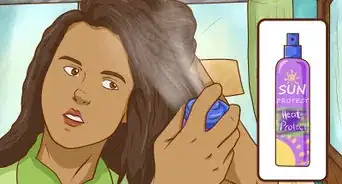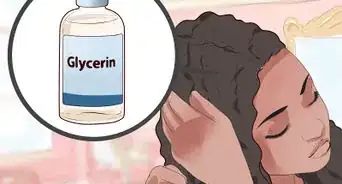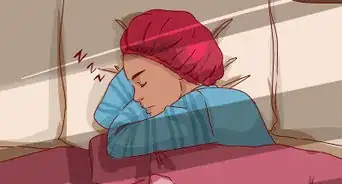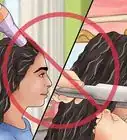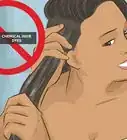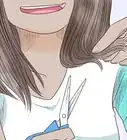This article was co-authored by Courtney Foster. Courtney Foster is a Licensed Cosmetologist, Certified Hair Loss Practitioner, and Cosmetology Educator based out of New York City. Courtney runs Courtney Foster Beauty, LLC and her work has been featured on The Wendy Williams Show, Good Morning America, The Today Show, The Late Show with David Letterman, and in East/West Magazine. She received her Cosmetology License from the State of New York after training at the Empire Beauty School - Manhattan.
wikiHow marks an article as reader-approved once it receives enough positive feedback. This article received 13 testimonials and 100% of readers who voted found it helpful, earning it our reader-approved status.
This article has been viewed 351,610 times.
African hair ranges from slightly wavy to extremely curly, but in general, its texture does tend to be drier and curlier than Caucasian or Asian hair. Luckily, there are many things you can do to take good care of it and keep it looking its best.
Steps
Washing and Conditioning African Hair
-
1Shampoo hair once a week.[1] African hair tends to be naturally dry with minimal oil, which is why it isn’t necessary to use shampoo more than once a week. Shampooing your hair several times a week or even every day strips the oil that the hair needs from the hair shaft so that it becomes drier, frizzier and more prone to breaking.[2]
- African hair does not often get overly oily like Caucasian or Asian hair does when it is not washed for several days.
- Do not wash tangled hair, as this will make the knots even worse. Always untangle hair and then wash.
-
2Condition your hair every time you shampoo. Because African hair tends to be dry, it’s essential to use conditioner every time you shampoo your hair to restore moisture. When you condition, pay attention especially to the ends of your hair, which are the most brittle, and keep the conditioner in your hair for a few minutes before washing it out.Advertisement
-
3Use a leave-in conditioner in washed hair. After you finish washing your hair, add in a generous amount of leave-in conditioner to the wet hair to continue adding moisture to the hair. Try to find a product that contains coconut oil, shea butter or cocoa butter.[3]
-
4Co-wash your hair between shampoos if physically active. If you exercise or build up a sweat regularly, you may feel the need to wash your hair more often than once a week to remove sweat or other buildup. Instead of using shampoo, wash with conditioner in between your weekly washes.
- Conditioner will gently wash away sweat or other buildup while keeping the healthy oils in your hair.
- Make sure to use the conditioner on your scalp as well as down your hair shaft.
-
5Use a leave-in moisturizer daily. Using a leave-in conditioner or moisturizer on days when you don’t wash or condition your hair ensures that your hair stays hydrated and protected from damage. Use a light leave-in moisturizer formulated for African hair at the beginning of the day before styling your hair.[4]
- Try to find a moisturizer that contains essential oils, which are absorbed into the hair and moisturize. Avoid products containing lanolin or other greasy ingredients that sit on the surface of the hair and weigh it down.
- Spritz your hair with water, then apply the moisturizer, or find a moisturizer than can be used on dry hair. Use the moisturizer on all of your hair, but pay special attention to the tips of your hair, which are the oldest and driest.
-
6Deep condition your hair once a month. In addition to your regular maintenance of your hair, doing a monthly or bimonthly deep conditioning treatment will make a visible difference to your hair, making it more moisturized and less brittle.[5] Use a deep conditioning product according to the label or get it done professionally for the best results.[6]
- Try to use a product that contains coconut oil, shea butter, or argan oil.
Detangling and Styling African Hair
-
1Untangle knots using product and a detangling comb. It’s important to untangle knots as soon as they form and before you wash your hair. Begin by spraying the knot with a mixture that is three parts water to one part olive or coconut oil. Apply your regular conditioner directly to the knot and from the roots of your hair to the tips on the knotted section. Then use your fingers to gently remove hair from the knot.[7]
- When you have partially untangled the knot, use a wide-toothed detangling comb to gently brush hair starting at the tips and working your way up the section, brushing down.
- It’s important to never try to comb or detangle knotted hair when it’s completely dry. Doing so is extremely difficult and will damage your hair. Dampening your hair and adding product makes the knotted section of hair more slippery so that the knot can come out easier.
-
2Use a blow dryer with a comb attachment to straighten. If you want to straighten your natural hair, let the hair air-dry partially, spray your hair with a heat protectant, then use a comb attachment on a blow dryer to gently brush the hair with heat to straighten it.[8]
-
3Style your hair in protective and low manipulation styles. If you are looking to style your hair as opposed to wearing it down, try styling it in protective and low-maintenance styles that keep your hair in place and require no daily manipulation or styling of the hair.[9]
- Braids, including box braids and cornrows, are classic and stylish protective styles. If you don't have long hair, you can braid synthetic hair in to give you extra length.
- Twists, including Senegalese twists and two strand twists are also good options for a protective style. Like with braids, you can also add in synthetic hair or even beads to add more to the look.
- You can also do updos such as bantu knots or buns.
-
4Choose a sewn-in weave. Wearing a weave can actually protect your hair as long as you choose a sewn-in weave as opposed to one glued to your hair, so If you want to wear a weave, have it professionally sewn-in to your hair unless you are very experienced. Visit your stylist every two or three weeks after getting the weave to make sure it stays tight to your hair and doesn’t pull on your natural hair.[10]
- Glued in weaves often rip your natural hair out when they are removed, whereas sewn-in weaves can be removed without any damage done to your hair.
- You can also wear a wig if you don’t want to have a weave put in. Simply put your hair up, put a wig cap on, and wear the wig.
-
5Let your hair rest in between two consecutive weaves. You can keep your weave in between one and a half to three months, depending on the advice of your stylist. After your second consecutive weave, you should get the weave removed and let your hair rest for about three weeks, as wearing weaves for too many months can strain your hair and scalp.[11]
-
6Get your hair relaxed professionally. Relaxing your hair does do a certain amount of damage, but the damage is far less if you get it done professionally as opposed to doing it at home. After your first session, you will need to get your newly grown hair near your scalp touched up every few weeks so that it matches your relaxed hair, but never get your whole head of hair relaxed twice, as this can severely damage your hair.[12]
Building Hair Health Through Your Lifestyle
-
1Eat a diet rich in hair-healthy nutrients. Make sure that your diet contains plenty of fatty acids, B vitamins, folic acid, and protein to promote the health and strength of your hair. Foods containing these nutrients include salmon and other fatty fish, nuts and eggs.
-
2Use a silk or satin pillowcase. One large cause of hair breakage is the friction that results from your hair rubbing against your pillowcase at night. Counter this damage by opting for silk or satin pillowcases, which create less friction and don’t absorb the moisture from your hair in the way that cotton pillowcases tend to do.
- If you don’t want to buy silk pillowcases, you can also wrap your hair in a silk or satin scarf at night.
-
3Wear silky shirts with shoulder-length hair. If you have shoulder-length hair, the constant rubbing of your hair against cotton shirts or shirts made of other absorbent material can sap the moisture from your hair and cause breakage. If you have shoulder length natural hair, try wearing silk or satin shirts when you wear your hair down.
Expert Q&A
Did you know you can get expert answers for this article?
Unlock expert answers by supporting wikiHow
-
QuestionHow can I maintain my thinning hair?
 Courtney FosterCourtney Foster is a Licensed Cosmetologist, Certified Hair Loss Practitioner, and Cosmetology Educator based out of New York City. Courtney runs Courtney Foster Beauty, LLC and her work has been featured on The Wendy Williams Show, Good Morning America, The Today Show, The Late Show with David Letterman, and in East/West Magazine. She received her Cosmetology License from the State of New York after training at the Empire Beauty School - Manhattan.
Courtney FosterCourtney Foster is a Licensed Cosmetologist, Certified Hair Loss Practitioner, and Cosmetology Educator based out of New York City. Courtney runs Courtney Foster Beauty, LLC and her work has been featured on The Wendy Williams Show, Good Morning America, The Today Show, The Late Show with David Letterman, and in East/West Magazine. She received her Cosmetology License from the State of New York after training at the Empire Beauty School - Manhattan.
Licensed Cosmetologist
-
QuestionHow can I get thicker hair?
 Courtney FosterCourtney Foster is a Licensed Cosmetologist, Certified Hair Loss Practitioner, and Cosmetology Educator based out of New York City. Courtney runs Courtney Foster Beauty, LLC and her work has been featured on The Wendy Williams Show, Good Morning America, The Today Show, The Late Show with David Letterman, and in East/West Magazine. She received her Cosmetology License from the State of New York after training at the Empire Beauty School - Manhattan.
Courtney FosterCourtney Foster is a Licensed Cosmetologist, Certified Hair Loss Practitioner, and Cosmetology Educator based out of New York City. Courtney runs Courtney Foster Beauty, LLC and her work has been featured on The Wendy Williams Show, Good Morning America, The Today Show, The Late Show with David Letterman, and in East/West Magazine. She received her Cosmetology License from the State of New York after training at the Empire Beauty School - Manhattan.
Licensed Cosmetologist There's really nothing that you can take internally that's going to help you grow thick hair, but you can use products that will coat the hair so it gives off the appearance of thicker hair. Thickening shampoos, thickening conditioners, and mousse can all help. You can also request different styles at the salon that will help give you the appearance of thicker hair.
There's really nothing that you can take internally that's going to help you grow thick hair, but you can use products that will coat the hair so it gives off the appearance of thicker hair. Thickening shampoos, thickening conditioners, and mousse can all help. You can also request different styles at the salon that will help give you the appearance of thicker hair. -
QuestionWhat can I do to avoid future hair loss?
 Courtney FosterCourtney Foster is a Licensed Cosmetologist, Certified Hair Loss Practitioner, and Cosmetology Educator based out of New York City. Courtney runs Courtney Foster Beauty, LLC and her work has been featured on The Wendy Williams Show, Good Morning America, The Today Show, The Late Show with David Letterman, and in East/West Magazine. She received her Cosmetology License from the State of New York after training at the Empire Beauty School - Manhattan.
Courtney FosterCourtney Foster is a Licensed Cosmetologist, Certified Hair Loss Practitioner, and Cosmetology Educator based out of New York City. Courtney runs Courtney Foster Beauty, LLC and her work has been featured on The Wendy Williams Show, Good Morning America, The Today Show, The Late Show with David Letterman, and in East/West Magazine. She received her Cosmetology License from the State of New York after training at the Empire Beauty School - Manhattan.
Licensed Cosmetologist
Things You’ll Need
- Shampoo
- Moisturizing conditioner
- Oil-based leave-in conditioner or moisturizer
- Deep conditioner
- Blow dryer with comb attachment
- Wide toothed detangling comb
- Silk or satin pillowcase
- Silk or satin scarf
References
- ↑ Courtney Foster. Licensed Cosmetologist. Expert Interview. 9 December 2019.
- ↑ https://www.aad.org/public/skin-hair-nails/hair-care/african-american-hair
- ↑ http://mybrownbaby.com/2012/11/detangling-washing-conditioning-black-girl-hair-this-is-how-we-do-it/
- ↑ http://www.curlynikki.com/2017/03/heres-4-tips-on-styling-type-4-hair.html
- ↑ Courtney Foster. Licensed Cosmetologist. Expert Interview. 9 December 2019.
- ↑ https://blacknaps.org/how-to-build-a-natural-hair-regimen/
- ↑ http://mybrownbaby.com/2012/11/detangling-washing-conditioning-black-girl-hair-this-is-how-we-do-it/
- ↑ http://www.more.com/beauty/hair/hair-care/black-hair-care-basics
- ↑ https://blacknaps.org/how-to-build-a-natural-hair-regimen/
About This Article
The best way to maintain African hair is to only shampoo your hair once a week. Condition your hair each time you wash it, and apply a leave-in conditioner to keep your hair moisturized. Spray a mixture of 3 parts water and 1 part coconut oil onto your hair before combing out tangles with a wide-toothed detangling comb. For advice on how to choose a weave and find the right pillowcase to prevent frizz, read on!
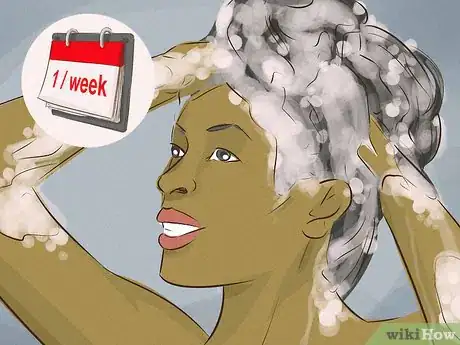

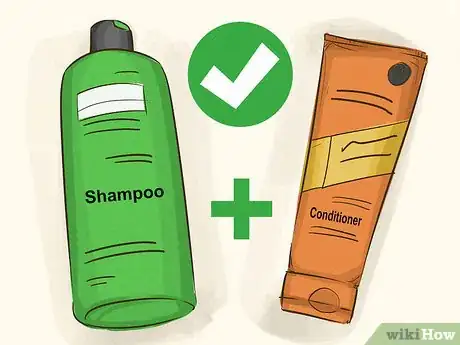

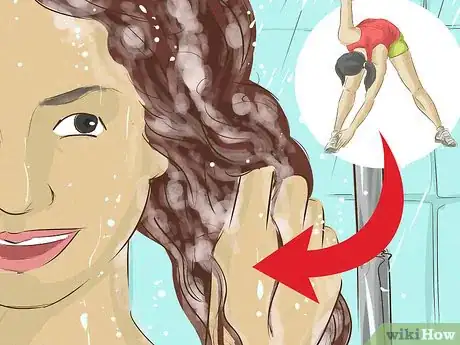
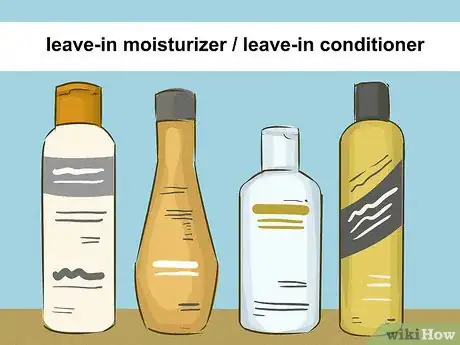
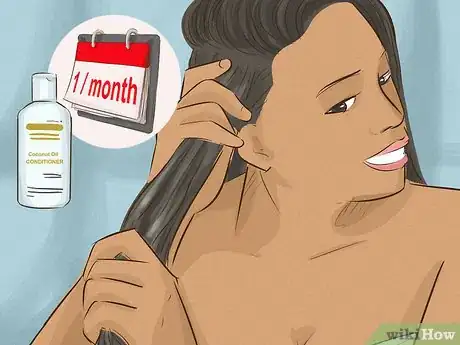
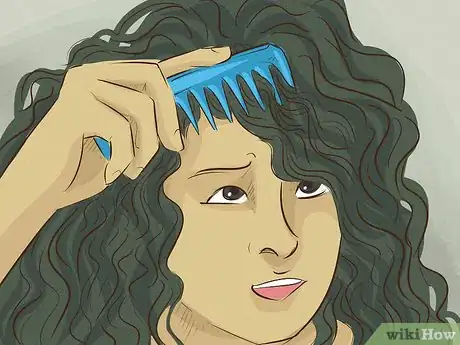
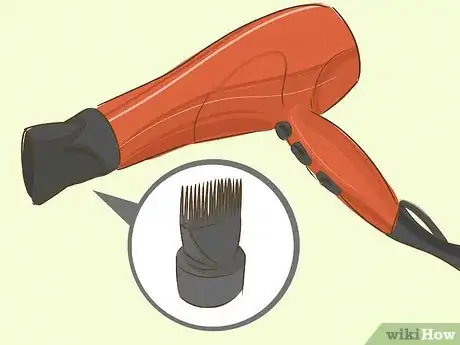
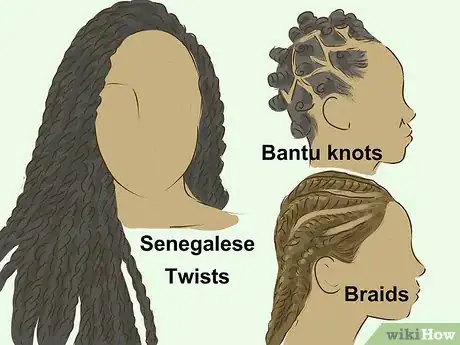
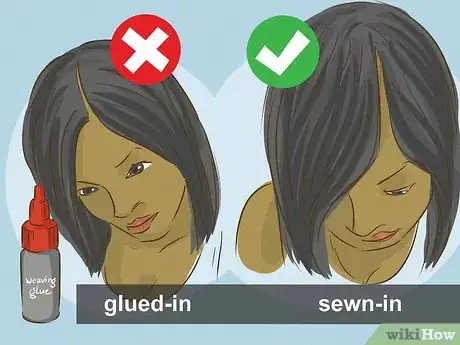
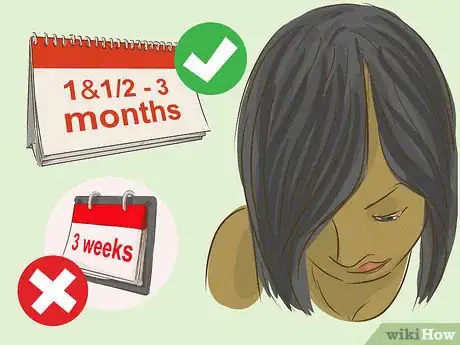
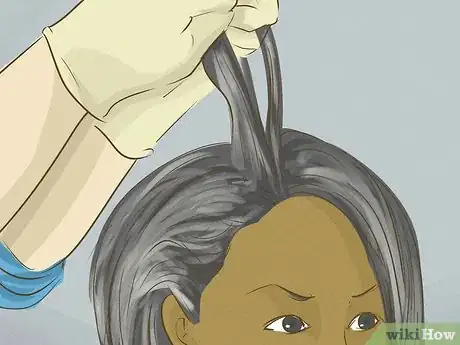
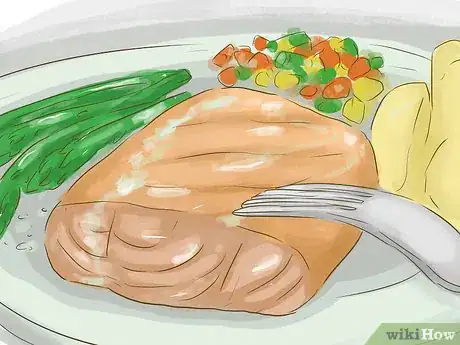
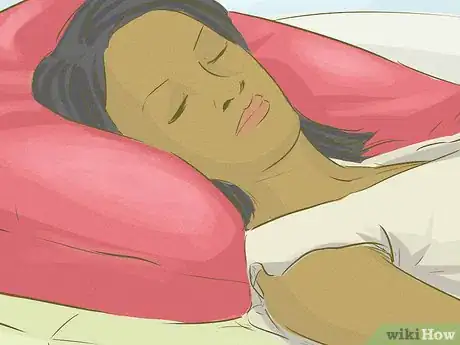
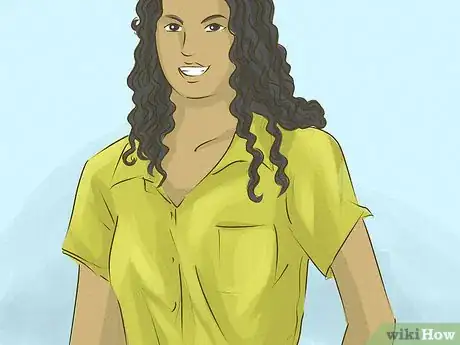
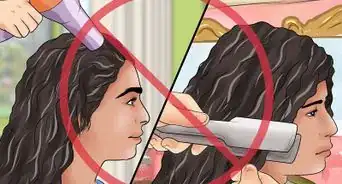
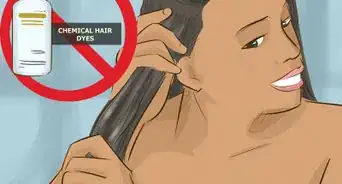
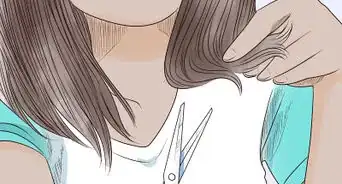
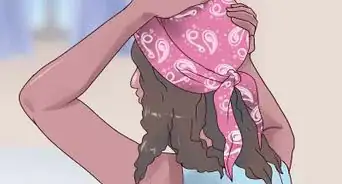


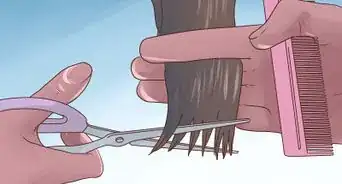
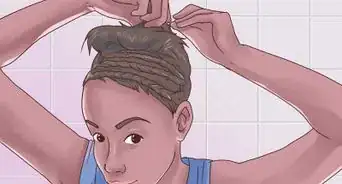
-Step-20.webp)
